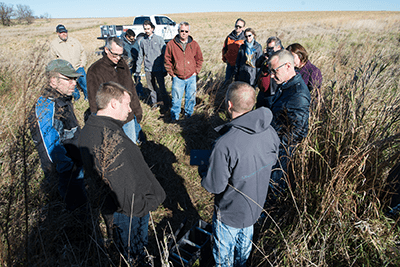From Urban and Rural Partnerships to Tenants and Farmers, the Keys to Improving Water Quality Lie in Collaborative Efforts
Members of the leadership team of Iowa’s Water Future Task Force who are looking for solutions to improving water quality had the opportunity to see and discuss what farmers are doing during a tour hosted by the Iowa Agriculture Water Alliance (IAWA) today.
The group learned about water quality improvement efforts on farms in central Iowa. In effect, the message was clear — from urban and rural partnerships to tenants and farmers, the keys to improving water quality lie in collaborative efforts.
Significant Improvement in Water Quality
“We are working toward creating a comprehensive plan with a variety of solutions to improve water quality and soil health for rural and urban Iowans alike,” said Jay Byers CEO of the Greater Des Moines Partnership and initiator of the Iowa’s Future Task Force. “Therefore, this tour provided an opportunity. We saw what farmers are doing and discussed how we can move forward with participation from all.”
The first tour stop showed collaboration between farmer Mike Helland of Alleman and his landowner Lee Tesdell. The pair believes in investing to make a significant improvement in water quality. Notably, they've partnered to implement conservation practices such as cover crops, terraces, grassed waterways and a bioreactor.
“Certain things are the right thing to do,” said Tesdell. “The topsoil on my field is going to stay in place thanks to these practices.” However, each piece of land needs something different to effectively improve water quality with attention to the dynamics of the systems.
Conservation Reserve Enhancement Program (CREP)
Similarly is Tim Minton farms near Grimes. He discussed his wetland project at the next tour stop. Minton purchased a farm five years ago that had a severe flooding issue. As a result, he turned to the Iowa Department of Agriculture and Land Stewardship’s (IDALS) Conservation Reserve Enhancement Program (CREP) for help finding a solution.
“The concept is to leave your footprint in a positive way for our kids and those who come after me,” said Minton. “Soil is the most important thing we own. If we don’t take care of it who will?”
Because of CREP, Minton was able to construct a wetland. It captures and naturally filters water from 1,000 acres in the Walnut Creek Watershed and ultimately delivers better water downstream. IDALS estimates that the state needs 7,000 CREP wetlands to have an impact. Consequentially right now, the state has 77.
Public and Private Investments
“This project is a great example of public as well as private investments utilized by the farmer and resulting in a public benefit. That’s exciting,” said Roger Wolf, the Iowa Soybean Association’s (ISA) director of Environmental Programs and Services whose team lead the tour.
As a result, collaborative projects and programs like these are cropping up all over the state. So why is collaboration important?
“It is in every Iowan’s best interest to have the cleanest water possible,” said Sean McMahon, IAWA executive director. “We all look to these water sources for our vitality and livelihood. The best path forward will be in working together.”

Iowa’s Water Future Task Force co-chairs Larry James and Steve Bruere and a host of others listen to ISA’s Keegan Kult explain how a bioreactor works to remove nitrates from water.
